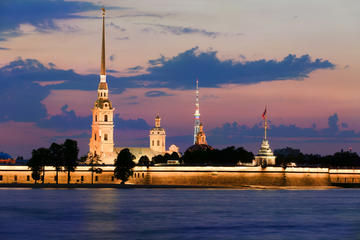
No visit to St Petersburg is really complete without spending a few hours at the site where it all began – the Peter & Paul Fortress. This is the original citadel of the city, built on Hare Island near the north bank of the Neva River between 1706 and 1740. And this is where you can get a feel for St Petersburg’s more than 300 year old history, from royal tombs to prison blocks to historical museum exhibitions.
The Peter & Paul Fortress was originally built to protect Russia’s new capital from a possible Swedish attack, but it never really served that purpose. Instead, it soon became a prison for high-ranking and political prisoners, beginning with Alexey, the son of Peter the Great. In 1872, a new prison within the walls of the Trubetskoy Bastion was built and over the next forty years, it held thousands of prisoners who were considered to be enemies of the state. These political prisoners included the likes of Feodor Dostoevsky, Leon Trotsky and Maxim Gorky and then, after the Bolshevik Revolution, members of the Tsarist government. The prison was turned into a museum in 1924 and today you can walk through the corridors, visit some of the cells and view documents and photographs that tell the story of Imperial Russia’s main political prison.
The most visible landmark within the Peter & Paul Fortress is the Peter & Paul Cathedral, whose spire stands more than 400 feet tall and features an angel at the top holding a cross. Built between 1712 and 1733, the cathedral was one of the first in Russia to be decorated with paintings and icons. The iconostasis was carved by Moscow craftsmen in the 1720s and contains 43 original icons from the 18th century. The bell tower of the cathedral is the world’s largest Orthodox bell tower and at the base of the tower lay the tombs of the Romanov monarchs. Every tsar and tsarina from Peter the Great to Nicholas II is buried within the Peter & Paul Cathedral, except Peter II and Ivan VI. Connected to the main cathedral by a corridor is the Grand Ducal Mausoleum, built between 1896 and 1908 to serve as a burial place for non-reigning members of the Romanov family.
In the Commandant’s House within the fortress, you will find displays exploring the early history of St Petersburg in the 18th and 19th centuries, including paintings, maps and layouts and pieces of graphic and applied art. Another section of the house aims to provide insight into the daily life of St Petersburg citizens in the 19th century. Exhibits reflect themes such as commerce and banking, life in an apartment house, transportation and city fashion.
After visiting the main sites within the fortress, spend some time walking along the top of the fortress walls for superb views of central St Petersburg, including the massive St Isaac’s Cathedral. If you are visiting St Petersburg in the summer, save some time to relax on the sandy beaches along the shores of the Neva. Finally, keep an eye out for temporary exhibitions that often provide even greater insight into St Petersburg’s vast history.